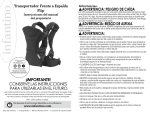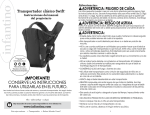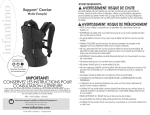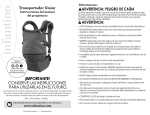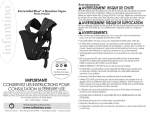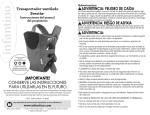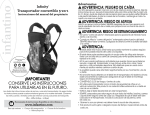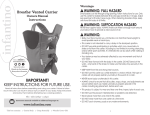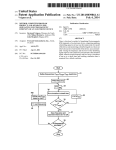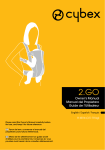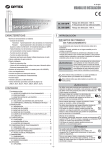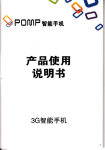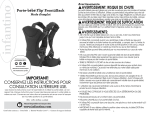Download IMPORTANT! - Infantino Blog
Transcript
English Flip Carrier TM Owners Manual Instructions Visit us online to view our instructional videos and learn more about our products at www.infantino.com IMPORTANT! KEEP INSTRUCTIONS FOR FUTURE USE. Read all instructions before assembling and using your carrier. Failure to follow each instruction can result in serious injury or death to your baby. Keep instructions and review them before attempting new carrying positions. 8lbs - 32lbs (3.6kgs 14.5kgs) This box contains: 1 - Carrier 1 - Wonder Cover 2-in-1 Bib TM Warnings: WARNING: FALL HAZARD Small babies can fall through a leg opening. Follow instructions for use. Only use this carrier for babies between 8 lbs (3.6 kgs) and 32 lbs (14.5 kgs). Adjust the leg openings to fit your child’s legs snugly. When fastening the shoulder straps, keep one hand on the baby at all times. Never leave a baby unattended in the carrier. The baby MUST be able to sit up on his/her own before being worn in the backpack position. WARNING: SUFFOCATION HAZARD NEVER lean against the baby. ALWAYS make sure there is enough room around your baby’s face to provide a clear source of air. WARNING: • KEEP AWAY from fire and heat sources. • Your balance may be adversely affected by your movement and that of your baby. • DO NOT lean forward with the baby in the carrier. DO NOT bend at the waist – only bend at the knees to make sure the baby stays securely in the carrier. • This carrier is not suitable for use during sporting activities. • IMPORTANT! Baby must face towards you until he or she can hold head upright. • ALWAYS check to assure all buckles, snaps, straps and adjustments are secure before each use. • DO NOT use this product if deterioration or problems are detected. • IMPORTANT! The carrier must be fitted to the user before placing the baby in the carrier for front facing positions. • DO NOT use this carrier as a child restraint in a motor vehicle. This product will not properly restrain your baby in the event of a crash. • Never place more than one child in this carrier. • DO NOT wear more than one carrier at a time. • DO NOT use in showers, pools or any water environments. 1. Uso de su babero 2 en 1: Posición de mirando hacia usted 1. Coloque el babero entre su pecho y la cabeza del bebé. El babero es reversible, de modo que cualquiera de sus lados puede estar mirando hacia fuera. 2. Fije el “babero 2 en 1” apretando los dos “círculos de gancho y lazo” a ambos lados del babero contra las dos “tiras de fijación del babero” situadas del lado inferior de las “correas para los hombros. 61. (Cualquier lado del babero puede estar mirando hacia fuera.) Fije el “babero 2 en 1” apretando los dos “círculos de gancho y lazo” a ambos lados del babero contra las dos “tiras de fijación del babero” situadas del lado inferior de las “correas para los hombros.” 62. El babero debe entonces doblarse sobre el soporte de la cabeza que ya está doblado hacia abajo. 30. Español Uso de su babero 2 en 1: Posición de mirando hacia fuera Para sacar al bebé del transportador: posición de mochila * ¡IMPORTANT! NUNCA se incline contra el bebé en el transportador. SIEMPRE asegúrese de que haya suficiente espacio alrededor del rostro de su bebé para proporcionar una fuente de aire libre. 61. Vuelva a un rincón seguro y siéntese cuidadosamente. Suelte las hebillas de la “correa del pecho y la espalda” y el “cinturón de soporte lumbar.” 62. Quite las “correas para los hombros” y baje lentamente al bebé de su espalda al rincón seguro. 63. Gire y póngase frente al bebé. Afloje ambos orificios para las piernas. Sosteniendo al niño con una mano, suelte la “hebilla de soporte de la cabeza” y la abertura del agujero para la pierna a un lado del transportador. Saque al bebé del transportador. 64. Opcionalmente se recomienda trasladar al bebé y al transportador a una superficie plana y nivelada antes de sacar al niño del transportador. 29. Helpful Hints: * How do you know if your baby is at the right height when worn in the front? - You should be able to tilt forward slightly and kiss the top of your child’s head. * Facing-out Position - Baby Facing Away from You - Once your child is able to hold his or her head up, your baby is ready for a new adventure. This position allows him or her to visually explore their surroundings while maintaining close contact with you. * When placing your baby in or taking them out of the carrier, sitting down will make the procedure easier. Until you are familiar with the placement of baby, it is also recommended to do so over a soft surface. * It is best to limit the use of your carrier to 10-20 minutes until you and your baby are both completely comfortable in it together. * When removing your baby from the carrier for a short time, it is useful to leave one side completely attached to eliminate any extra steps when returning the baby to the carrier. * Backpack Position - Child Facing Forward - When your little one can fully sit up on his or her own, putting them on your back allows you to carry the child comfortably for longer periods of time. In this position your baby is free to check out what is going on around them and still know that you are right there. * Wearing the carrier closer to your body and higher up on your back (or chest when worn in the front position) will minimize stress to your back and shoulders from prolonged use. Care Instructions Machine wash cold, separately, on gentle cycle with mild detergent. Do NOT bleach. Do NOT use fabric softeners. Wipe clean with cloth or sponge between machine washings. Drip dry. DO NOT iron. 2. English * Facing-in Position - Baby Facing Toward You - Until your child is able to hold his or her head upright, this is the ideal position. It affords your baby lots of close physical contact and attention, while leaving your hands free. In this position. You can entertain and bond with your newborn by talking, touching, playing or just making eye-contact. Carrier Body Front: Padded Head and Back Support Head Support Buckle/ Tightener 2-in-1 Bib Attachment Strips: Facing-out (inside carrier body) 2-in-1 Bib Attachment Strip: Facing-in Shoulder Strap Adjuster Storage Pocket Hook & Loop Shoulder Strap End 3. Carrier Body Back: Padded Shoulder Straps 2-in-1 Bib Attachment Strips: Facing-in Chest/Back Strap and Tightener Side Closure Buckle Leg Opening Lumbar Support Strap and Tightener 4. Instructions: Placing baby in your carrier: Facing-in position * IMPORTANT! Your baby must face toward you until he/she is able to hold head upright. * When using this carrier in the facing-in position, please fit it to the user before placing the baby in the carrier. * Keep one hand on the baby until all the buckles and straps are properly fastened. 1. To begin, unfasten the “chest/back strap” and “lumbar support belt” buckles. Hold the carrier with the straps facing towards you. (The straps should form a “V”) 2. Place your arms through the “shoulder straps” making sure that the foam padding rests on your shoulders. 3. With the “shoulder straps” in place, reach behind your back to connect the “chest/back buckle.” If you need assistance, have another person fasten the buckle and adjust its tightness. On both sides, pull down on each “shoulder strap” to tighten, then roll any excess strap in towards the carrier and secure with the “hook & loop” fasteners. 5. English 1 Fasten the “lumbar support belt” around your waist. Slide the belt around your waist until the padded area is centered on your back. Pull the strap to tighten and secure the belt, making sure the padded support area remains centered. Any excess strap may be rolled in toward the carrier and secured with the “hook & loop” fastener. English 4. 5. Once the carrier is properly fitted to your body, completely open either side of the carrier. To release the “head support buckle,” press in on the sides of the buckle and pull the two sections apart. 6. Open the leg hole area on the same side as the open “head support buckle” by releasing the “side closure buckle” located in the leg hole area and pulling open the “hook & loop.” 7. Lift the baby facing you. While holding the child securely, place him or her into carrier through the opening, ensuring that the baby’s leg goes through the leg hole on the side which is still fastened. 6. 8. While still holding the child securely, close the open leg hole by reattaching the “hook & loop” and fastening the buckle. Adjust both leg hole openings to snugly fit the baby’s legs. 9. While still supporting the baby’s weight, fasten the “head support buckle” by inserting the upper portion of the buckle (on the shoulder strap) into the lower section (located on the head support). Push the “side closure buckle” together until you hear a click. Before releasing your hold of the baby, ensure that the “side closure buckle” is locked in place by pulling down on the buckle. 10. If necessary, tighten the “shoulder straps” by pulling forward on the webbing portion at the base of the strap while gently lifting the baby by the bottom. When the straps are properly tightened, you should be able to kiss the top of your child’s head. 7. 2 Placing your baby in your carrier: Facing-out position * When using this carrier in the facing-out position, please fit it to the user before placing the baby in the carrier. * IMPORTANT! Keep one hand on the baby until all the buckles and straps are properly fastened. 1. Fit the carrier to your body as detailed in steps 1-4, 1 PLACING BABY IN YOUR CARRIER: Facing-in position 2. Open either side of the carrier as detailed in steps 5 and 6 1 PLACING BABY IN YOUR CARRIER: Facing-in position 3. Fold the head support area down. Pick up the baby facing away from you. While holding the baby securely, place him or her into the carrier through the opening, ensuring that the child’s leg goes through the leg hole which is still fastened. 4. While still holding the child securely, close the open leg hole by reattaching the “hook & loop” and fastening the “side closure buckle”. Adjust both leg hole openings to snugly fit the baby’s legs. 8. English * WARNING! Your baby must face toward you until he/she is able to hold head upright. 5. While still supporting the baby’s weight, fasten the “head support buckle” by inserting the upper portion of the buckle (on the shoulder strap) into the lower section (located on head support). Push the buckle together until you hear a click. Before releasing your hold of the child, ensure that the buckle is locked in place by pulling down on the buckle. PLEASE NOTE! * A smaller baby’s arms should be positioned through the arm holes. * A larger child’s arms will rest comfortably over the “headrest.” 6. If necessary, tighten the “shoulder straps” by pulling forward on the webbing portion at the base of the strap while gently lifting the baby by the bottom. When the straps are properly tightened, you should be able to kiss the top of your child’s head. * IMPORTANT! The baby should not be leaning forward. 9. 3 Placing older baby in your carrier: Backpack position * IMPORTANT! The baby MUST be able to sit up on his or her own before being worn in the backpack position. * For the backpack position, the child is first placed in the carrier and then the carrier is put on the user. Adjustments of straps and belts for proper fit are performed while the user is wearing the carrier. Step 1. Placing baby in the carrier 1. To place the baby in the carrier, first open one side of the carrier by releasing the “head support buckle” and by unfastening the “side closure buckle” and the “hook & loop” at the same side leg opening. 2. Rotate the “lumbar support belt” so that the padded section is centered in the channel attached to the base of the carrier. 3. With the carrier on a safe, flat, level surface with the straps up, place the baby facing up into the carrier. Check that the child’s leg extends through the closed side leg hole opening. 4. Secure the open leg hole around the baby’s free leg by attaching the “hook & loop” and fastening the buckle. Adjust both leg hole openings to snugly fit the child’s legs. 10. English * STOP! First time users, DO NOT attempt to use the carrier in the backpack position without the assistance of a second person. We highly recommend always using the assistance of a second person. 5. Fasten the “head support buckle” by inserting the upper portion of the buckle (on the shoulder strap) into the lower section (located on the head support). Push the buckle together until you hear a click. Ensure that the buckle is locked in place by trying to pull it apart. Adjust tightness of “head support buckle” as necessary. Step 2. Putting on the carrier: Backpack position 6. 6A. 7. RECOMMENDED: If another person is available, have him or her lift the child in the carrier to the proper height. Slip your arms through the “shoulder straps” and connect the “chest/back strap” (located on the “shoulder straps”), and the “lumbar support belt.” Adjust all straps and the belt for a proper fit, while your partner continues to support the weight of the child. ALTERNATIVE: If it is necessary to put the carrier on without assistance, set the carrier and baby in a secure corner (like a couch) so that baby’s back is supported and the baby is sitting upright. Keep the straps clear of the baby’s face. Gently sit in front of the baby close enough for the child’s legs to wrap around your body. * IMPORTANT! NEVER lean against the baby. ALWAYS make sure there is enough room around your baby’s face to provide a clear source of air. 11. 9. 10. Attach the “lumbar support belt” around your waist with the buckle, place your arms through the “shoulder straps” and fasten the “chest/back buckle” located on the “shoulder straps.” English 8. To ensure that your baby is securely on your back, tighten the “shoulder straps,” the “chest/ back strap” and the “lumbar support belt” as necessary. Once the baby is secure, stand slowly. If needed, use another person to help maintain your balance. * IMPORTANT! Your balance may be adversely affected by your movement and that of your baby. * IMPORTANT! DO NOT lean forward or backward with the baby in the carrier. Do not bend at the waist – only bend at the knees to make sure the baby stays securely in the carrier. * IMPORTANT! If you feel the baby is not secure, sit down slowly and carefully and readjust the “shoulder straps.” 12. Removing the child from the carrier: Front position, facing-in/out * IMPORTANT! When releasing the baby from the carrier, keep at least one hand on the baby at all times. 1. First of all, loosen both leg holes to make it easier to pull the baby’s legs out. 2. Keeping one hand securely on the baby, release the two “head support buckles” first on the side of the carrier that you wish to remain closed, then on the entry/exit side. Release one of the “side closure buckles” and separate the “hook & loop” to completely open one side of the carrier. 3. Holding the baby with both hands, slide him or her out of the open side of the carrier. Place the child in a safe location before removing the carrier from your body. 13. * IMPORTANT! NEVER lean against the baby. ALWAYS make sure there is enough room around your baby’s face to provide a clear source of air. 61. Return to a secure corner and sit down carefully. Unbuckle the “chest/back strap” and the “lumbar support belt.” 62. Remove the “shoulder straps” and slowly lower the baby off your back into the secure corner. 63. Turn and face the baby. Loosen both leg holes. While supporting the child with one hand, release the “head support buckles” on both sides and the “side closure buckle” on one side of the carrier. Lift the baby out of carrier. 64. Alternatively, you may want to move the baby and carrier to a flat level surface before extracting the child from the carrier. 14. English Removing the child from the carrier: Backpack position Using your 2-in-1 bib: Facing-in position 1. Place the bib between your chest and the baby’s head. The bib is reversible, so either side can be facing out. 2. Attach the “2-in-1 bib” by squeezing the two “hook & loop circles” on either side of the bib against the two “bib attachment strips” located on the underneath side of the “shoulder straps.” Using your 2-in-1 bib: Facing-out position 61. (Either side of the bib can be facing out.) Attach the “2-in-1 bib” by squeezing the two “hook & loop circles” on either side of the bib against the two “bib attachment strips” located inside the carrier body on either side, near the baby’s chest. 62. The bib should then be folded over the already folded down head support. 15. Manual del propietario de Flip TM Español ¡IMPORTANTE! CONSERVE ESTAS INSTRUCCIONES PARA UTILIZARLAS MÁS ADELANTE. Lea todas las instrucciones antes de armar y usar su transportador. ¡ADVERTENCIA! No seguir todas estas instrucciones puede dar como resultado lesiones graves o la muerte de su bebé. Conserve las instrucciones y revíselas antes de intentar posiciones de transporte nuevas. 8lbs - 32lbs (3.6kgs 14.5kgs) Esta caja contiene: 1 transportador 1 babero Wonder CoverTM 2 en 1 16. Advertencias: ADVERTENCIA: PELIGRO DE CAÍDAS Los niños pequeños pueden caer por una de las aberturas para las piernas. Siga las instrucciones de uso. Sólo use este transportador para bebés de entre 8 lb (3.6 kg) y 32 lb (14.5 kg). Ajuste las aberturas para las piernas de modo que se adapten bien a las piernas de su bebé. Al atar las correas de los hombros, mantenga una mano en el bebé en todo momento. Nunca deje a un bebé desatendido en el transportador. El bebé DEBE poder sentarse por sí mismo antes de poderse usar en posición de carrito de la compra. ADVERTENCIA: RIESGO DE ASFIXIA NUNCA se apoye contra el bebé. SIEMPRE asegúrese de que haya suficiente espacio alrededor del rostro de su bebé para proporcionar una fuente de aire libre. ADVERTENCIA: • CONSÉRVELO LEJOS del fuego y fuentes de calor. • Su equilibrio se puede ver afectado negativamente por su movimiento y el de su hijo. • No se incline hacia delante con el bebé en el transportador. No se doble por la cintura; sólo doble las rodillas para asegurarse de que el bebé se mantenga fijo en el transportador. • Este transportador no es adecuado para ser usado durante actividades deportivas. • ¡IMPORTANTE! El niño debe mirar hacia usted hasta que pueda mantener erguida la cabeza. • Asegúrese SIEMPRE de que todas las correas y ajustes estén seguros y de que su bebé esté debidamente colocado en el transportador antes de cada uso. • NO USE EL PRODUCTO SI SE DETECTAN DETERIOROS O PROBLEMAS. • ¡IMPORTANTE! El transportador se debe ajustar a la persona que lo usa antes de colocar al bebé en el transportador en las posiciones de mirando al frente. • NO use este transportador como fijación para el niño en un vehículo de motor. Este producto no retendrá debidamente a su hijo en caso de un choque. • NO coloque más de un niño en el transportador. • Nunca use más de un transportador a une tiempo. • NO lo use en las duchas, piscinas o cualquier ambientes de agua. 17. Sugerencias Útiles: * Posición frontal - Niño mirando hacia usted - Hasta que el niño pueda sostener erguida la cabeza, ésta es la posición ideal. Le aporta a su bebé mucho contacto cercano y atención, al tiempo que le deja libres las manos a usted. En esta posición, puede divertir a su bebé y establecer lazos con él hablando, tocándose, jugando o simplemente mirándose a los ojos. * ¿Cómo sabe si el bebé está a la altura correcta cuando lo lleva al frente? - Usted debe poder inclinarse ligeramente y besar la parte superior de la cabeza de su bebé. * Posición frontal - Niño mirando hacia fuera - Una vez que el niño pueda sostener erguida la cabeza, está listo para una nueva aventura. Esta posición le permite explorar visualmente su entorno al tiempo que mantiene un estrecho contacto con usted. * Al cargar o descargar a su bebé en el transportador, sentarse hará más seguro el procedimiento. * Al quitar a su bebé del transportador durante un breve tiempo, es útil dejar un lado totalmente cerrado para eliminar los pasos adicionales al devolver al bebé al transportador. * Posición de mochila - Niño mirando hacia delante - Cuando su pequeño se pueda sentar erguido totalmente por sí mismo, llevarlo en la espalda le permite transportarlo cómodamente durante períodos de tiempo más prolongados. En estas posición, su bebé tiene libertad de revisar lo que está pasando a su alrededor y seguir sabiendo que usted está allí. * Llevar el transportador más cerca de su cuerpo y más alto en la espalda (o en el pecho cuando lo lleve en posición frontal) reducirá al mínimo la tensión en su espalda y hombros por el uso prolongado. Instrucciones de Lavado: Lave a máquina en agua fría, por separado, en ciclo suave y con un detergente suave. NO use blanqueador. NO use suavizantes de telas. Límpielo con un paño o esponja entre los lavados a máquina. Deje que seque escurriendo. NO lo planche. 18. Español * Es mejor limitar el uso de su transportador a 10 ó 20 minutos hasta que usted y su bebé estén totalmente cómodos juntos en él. Transportador de Frente: Soporte de la Cabeza y para la Espalda Hebilla del Soporte de la Cabeza/ Tensor Tiras de Fijación del Babero 2 en 1: Mirando hacia Fuera (adentro, no se muestra) Bolsillo de Almacenamiento. Gancho y Lazo Tiras de Fijación del Babero 2 en 1: mirando hacia usted (adentro, no se muestra) El Fin de la Correa del Hombro 19. Ajustador de la Correa Para el Hombro Transportador de Atras: Correa para el Hombro Tiras de Fijación del Babero 2 en 1: Mirando Hacia Usted (adentro, no se muestra) Pecho/Espalda y Tensor de Correa La Apertura de la Pierna Cinturón de Soporte Lumbar y Tensor 20. Español Hebilla de Cierre Lateral Instrucciones: 1 Cómo ponerse el transportador: Posición Mirando Hacia usted * ¡IMPORTANTE! El niño ÚNICAMENTE debe llevarse en posición de “mirando hacia dentro” hasta que pueda sostener erguida la cabeza. * Al usar este transportador en posición frontal, ajústelo al usuario antes de colocar al niño en él. * SIEMPRE mantenga una mano en el bebé hasta que todas las hebillas y correas estén debidamente cerradas. 1. Para empezar, suelte las hebillas de la “correa del pecho y la espalda” y el “cinturón de soporte lumbar”. Sostenga el transportador con las correas mirando hacia usted. (Las correas deben formar una “V). 2. Pase los brazos a través de las “correas de los hombros”, asegurándose de que el acolchado de espuma descanse sobre sus hombros. 3. Con las “correas de los hombros” en su sitio, extienda los brazos a su espalda para conectar la “hebilla del pecho y la espalda. Si necesita ayuda, pida a otra persona que le cierre la hebilla y ajuste la tensión. A ambos lados, tire hacia abajo de cada “correa de los hombros” para apretarla y enrolle la correa sobrante hacia el transportador, fijándola con los sujetadores de “gancho y lazo.” 4. Ajuste el “cinturón de soporte lumbar” alrededor de su cintura. Deslice el cinturón alrededor de la cintura hasta que el área acolchada esté centrada en su espalda. Tire de la correa para apretarla y cierre el cinturón, cuidando de que el área de soporte acolchada permanezca centrada. Los extremos sobrantes de las correas se pueden enrollar hacia el transportador y fijar con los sujetadores de “gancho y lazo.” 21. Una vez que el transportador esté debidamente ajustado a su cuerpo, abra cualquiera de los lados del transportador. Para soltar la “hebilla del soporte de la cabeza”, oprima los lados de la hebilla y tire de las dos secciones para separarlas. 6. Abra el área del orificio para la pierna del mismo lado que la “hebilla del soporte de la cabeza” abierta liberando la “hebilla de cierre lateral” situada en el área del agujero para la pierna y abriendo el “gancho y lazo.” 7. Levante al bebé mirando hacia usted. Sosteniendo al bebé firmemente, colóquelo en el transportador a través de la abertura, asegurándose de que la pierna del bebé pase por el agujero para la pierna del lado que sigue cerrado. 8. Sosteniendo al bebé con seguridad, cierre la abertura para la pierna que está abierta cerrando de nuevo el “gancho y lazo” y cerrando la hebilla. Ajuste ambas aberturas para las piernas de modo que se adapten bien a las piernas de su bebé. 9. Siga sosteniendo el peso del bebé y cierre la “hebilla del soporte de la cabeza” insertando la porción superior de la hebilla (en la correa para el hombro) en la sección inferior (situada en el soporte de la cabeza). Una la “hebilla de cierre lateral” a presión hasta que escuche un clic. Antes de soltar al bebé, tire de la “hebilla de cierre lateral” hacia abajo para asegurarse de que esté bien cerrada en su sitio. 22. Español 5. 10. 2 De ser necesario, apriete las “correas de los hombros” tirando hacia delante de la parte de la malla en la base de la correa mientras levanta suavemente al bebé por el trasero. Cuando las correas estén debidamente apretadas, usted debe poder besar la parte superior de la cabeza de su bebé. Para colocar al bebé en el transportador: Posición de mirando hacia fuera * ADVERTENCIA: El niño ÚNICAMENTE debe llevarse en la posición de “mirando hacia dentro” hasta que pueda sostener erguida la cabeza. * Al usar este transportador en posición mirando hacia fueral, ajústelo al usuario antes de colocar al niño en él. * ¡IMPORTANTE! SIEMPRE mantenga una mano en el bebé hasta que todas las hebil las y correas estén debidamente cerradas. 1. Ajústese el transportador en el cuerpo como se detalla en las instrucciones del las procedimiento 1-4, 1 PARA COLOCAR AL BEBÉ EN EL TRANSPORTADOR: Posición de mirando hacia usted 2. Abra cualquier lado del transportador como se detalla en las instrucciones 5 y 6 del Procedimiento, 1 PARA COLOCAR AL BEBÉ EN EL TRANSPORTADOR: Posición de mirando hacia usted 3. Doble hacia abajo el área del soporte de la cabeza. Levante al bebé mirando hacia fuera. Sosteniendo al bebé firmemente, colóquelo en el transportador a través de la abertura, asegurándose de que la pierna del bebé pase por el agujero de la pierna del lado que sigue cerrado. 23. 4. 5. Manteniendo al bebé afianzado con seguridad, cierre la abertura de la pierna abierta cerrando de nuevo el “gancho y lazo” y cerrando la “hebilla de cierre lateral”. Ajuste ambas aberturas para las piernas de modo que se adapten bien a las piernas de su bebé. Siga sosteniendo el peso del bebé y cierre la “hebilla del soporte de la cabeza” insertando la porción superior de la hebilla (en la correa para el hombro) en la sección inferior (situada en el soporte de la cabeza). Una la hebilla a presión hasta que escuche un clic. Antes de soltar al bebé, tire de la hebilla hacia abajo para asegurarse de que esté bien cerrada en su sitio. * Los brazos de los bebés mayores descansarán có modamente sobre el “soporte para la cabeza.” 6. Manteniendo el área del soporte de la cabeza doblada hacia abajo, apriete las “hebillas del soporte de la cabeza” de modo que la espalda del bebé esté ajustada contra su pecho. * ¡IMPORTANTE! El niño NUNCA debe estar inclinado hacia delante en el transportador. 24. Español ¡TENGA PRESENTE! * Los brazos de los bebés más pequeños deben posicionarse a través de los orificios para los brazos. 3 Para colocar al bebé en el transportador: Posición de mochila * ¡USUARIOS POR PRIMERA VEZ, ALTO! NO intente usar este transportador en posición de mochila sin la ayuda de otra persona. Por la seguridad del niño, recomendamos especialmente que SIEMPRE tenga la ayuda de otra persona al usar el transportador en posición de mochila. * ¡IMPORTANTE! El bebé DEBE poder sentarse erguido por sí mismo antes de poder llevarlo en posición de mochila. * Para la posición de mochila, el bebé se coloca primero en el transportador y después éste se pone en el usuario. Los ajustes de las correas y cinturones para una adaptación correcta se realizan mientras el usuario lleva el transportador. Step 1. Para colocar al bebé en el transportador 1. Para colocar al bebé en el transportador, abra primero un lateral del transportador liberando la “hebilla de soporte de la cabeza” y soltando la “hebilla de cierre lateral” y el “gancho y lazo” de la abertura de la pierna de ese lado. 2. Gire el “cinturón de soporte lumbar” de modo que la sección acojinada esté centrada en el canal conectado a la base del transportador. 3. Con el transportador en una superficie plana, segura y nivelada, con las correas hacia arriba, coloque al bebé boca arriba en el transportador. Asegúrese de que la pierna del bebé se extienda por la abertura para la pierna del lado que está cerrado. 4. Asegure la abertura para la pierna que está abierta alrededor de la pierna libre del bebé conectando el “gancho y lazo” y cerrando la hebilla. Ajuste ambas aberturas para las piernas de modo que se adapten bien a las piernas de su bebé. 25. 5. Cierre la “hebilla del soporte de la cabeza” insertando la porción superior de la hebilla (en la correa para el hombro) en la sección inferior (situada en el soporte de la cabeza). Una la hebilla a presión hasta que escuche un clic. Tire de la hebilla tratando de separarla para asegurarse de que esté bien cerrada. Ajuste la tensión de la “hebilla del soporte para la cabeza” según sea necesario. Step 2. Cómo ponerse el transportador: Posición de mochila 6. 6A. ALTERNATIVO: Si necesita colocarse el transportador sin ayuda, ponga al transportador y al bebé en un rincón seguro (como un sofá) de modo que la espalda del bebé esté apoyada y el bebé esté sentado recto. Asegúrese de que las correas no cubran el rostro del bebé 7. Siéntese suavemente frente al bebé, lo bastante cerca para que las piernas del bebé rodeen su cuerpo * ¡IMPORTANTE! NUNCA se incline contra el bebé en el transportador. SIEMPRE asegúrese de que haya suficiente espacio alrededor del rostro de su bebé para proporcionar una fuente de aire libre. 26. Español RECOMENDADO: Si tiene otra persona disponible, haga que levante al niño en el transportador a la altura adecuada. Deslice sus brazos por las “correas de los hombros” y conecte la “correa del pecho y la espalda” (situada en las “correas para los hombros”) y el “cinturón de soporte lumbar”. Ajuste todas las correas y el cinturón para una adaptación adecuada, mientras que su compañero sigue sosteniendo el peso del niño. 8. 9. 10. Conecte el “cinturón de soporte lumbar” alrededor de la cintura con la hebilla, deslice los brazos por las “correas para los hombros” y cierre la “hebilla del pecho y espalda” está situada en las “correas para los hombros”. Para asegurarse de que su bebé esté seguro en su espalda, apriete las “correas de los hombros”, la “correa del pecho y espalda” y el “cinturón de soporte lumbar” según sea necesario. Una vez que el bebé esté seguro, póngase de pie lentamente. De ser necesario, use a otra persona para ayudarle a mantener el equilibrio. * ¡IMPORTANTE! Tenga cuidado de modo que sus movimientos o los de su bebé no le hagan perder el equilibrio. * ¡IMPORTANTE! NUNCA se incline hacia delante ni hacia atrás con el bebé en el transportador. Inclínese ÚNICAMENTE doblando las rodillas, NUNCA la cintura, para conservar el equilibrio y asegurarse de que el bebé se mantenga seguro en el transportador. * ¡IMPORTANTE! Si siente que el bebé no está seguro, siéntese lentamente y con cuidado y vuelva a ajustar las “correas para los hombros”. 27. Para sacar al bebé del transportador: Posición frontal mirando hacia dentro o hacia fuera * ¡IMPORTANTE! Al liberar al bebé del transportador, mantenga al menos una mano en el bebé en todo momento. Primero que nada, afloje ambas aberturas de las piernas para que sea más fácil sacar las piernas del bebé. 2. Manteniendo una mano firmemente en el bebé, liberar a los dos “, hebillas de soporte para la cabeza” por primera vez en el lado de la compañía que desea permanecer cerrada, a continuación, sobre la entrada y salida de lado. Suelte una de las “hebillas de cierre de lado” y separar el “gancho y lazo” para abrir completamente una parte de la compañía. 3. Sosteniendo al bebé con ambas manos, deslícelo para sacarlo del lado abierto del transportador. Coloque al bebé en un lugar seguro antes de quitarse el transportador del cuerpo. 28. Español 1. Designed with in California © 2010 Infantino, LLC 4920 Carroll Canyon Road, Suite 200 | San Diego, CA 92121 USA www.infantino.com A Step2 Family Company® Infantino, Ltd. Prospect House Business Center, High Wycombe HP13 6LA, UK BEFORE USING THIS CARRIER: Review and save the Instruction Manual for future reference. Please call Infantino at 1-800-840-4916 (for US or Canada) or 00+1 858-457-9797 in Europe with any questions or visit our website www.infantino.com. Made in China. Complies with safety requirements of ASTM F2236-09a ANTES DE USAR ESTE TRANSPORTADOR: Revise y guarde el Manual de Instrucciones para consultarlo posteriormente. Llame a Infantino al 1-800-840-4916 (para los EE.UU. o Canadá) o al 00+1 858-457-9797 en Europa para hacer cualquier pregunta, o visite nuestro sitio Web en www infantino.com. Hecho en China. Cumple o supera las normas ASTM F2236-09a

































